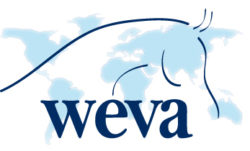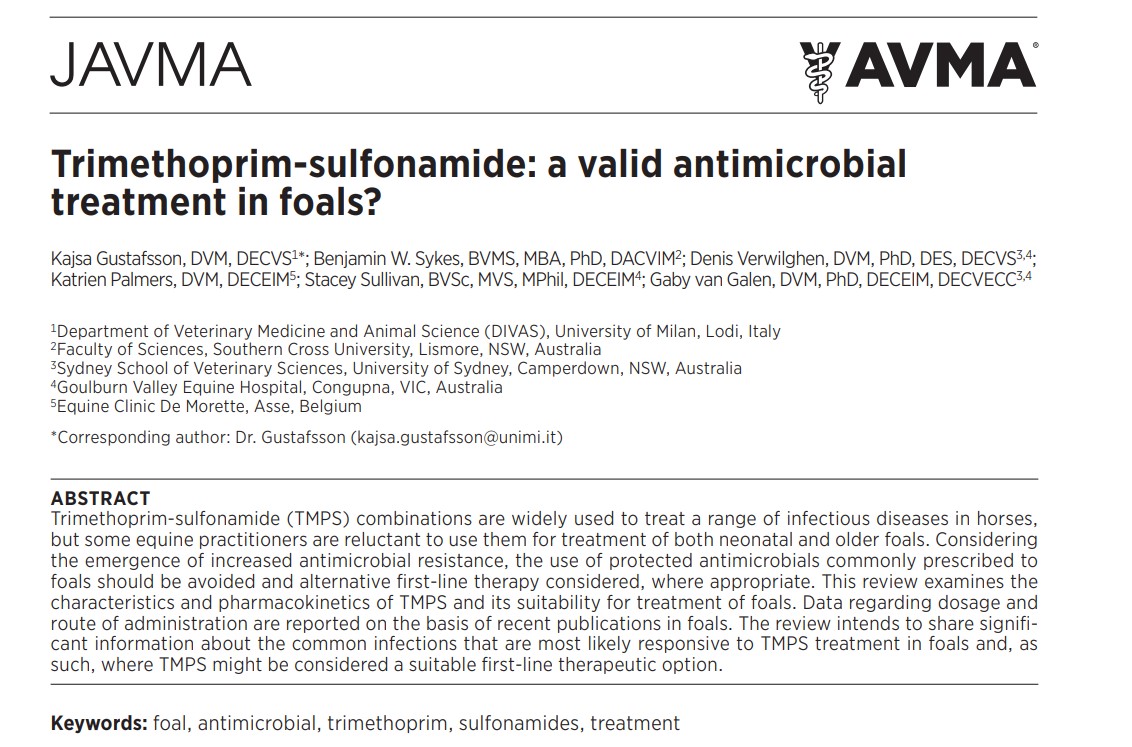Every month, we select an open-access article as our WEVA’s Pick of the Month to encourage educational and professional development in the equine field. Please enjoy the articles below:
June
Diagnostic approach to chronic diarrhoea in adult horses
E. Sjolin | A. Lack | L. G. Arroyo
| Correspondence: L. G. Arroyo Email: larroyo@uoguelph.ca Department of Clinical Studies, Ontario Veterinary College, University of Guelph, Guelph, Ontario, Canada |
Reason for our pick: Chronic diarrhoea in adult horses presents a significant diagnostic challenge due to its multifactorial nature and the lack of a standardized definition in equine veterinary literature. This comprehensive review by Arroyo et al. offers a structured diagnostic approach, emphasizing the importance of thorough history-taking, physical examination, and targeted diagnostic testing. The article serves as a valuable resource for equine practitioners aiming to enhance their diagnostic acumen and improve patient outcomes in cases of chronic diarrhoea.

April
Review of intra-articular local anaesthetic administration in horses: Clinical indications, cytotoxicity, and outcomes
Aaron Webster | Lynn Pezzanite | Dean Hendrickson | Gregg Griffenhagen
| Correspondence Gregg Griffenhagen Department of Clinical Sciences, College of Veterinary Medicine and Biomedical Sciences, Colorado State University, Fort Collins, Colorado, USA Email: gregg.griffenhagen@colostate.edu |
Reason for our pick: Intra-articular local anaesthetic injections are a staple in equine practice—but how much do we really know about their long-term effects? This comprehensive review explores the science behind common anaesthetics, their potential chondrotoxicity, and how additives may help protect joint health. A must-read for vets looking to balance effective pain relief with joint preservation.

February
Australian guidelines for equine internal parasite management
| A Beasley,a G Abbas,b K Hughes,c C El-Hage,b C Jacobson,d J Bauquier,b E Wilkes,e P Carrigan,f L Cudmore,f J Hurley,g I Beveridge,b M Nielsenh and A Jabbarb* |
|||
| *Corresponding author. aSchool of Agriculture and Food Sustainability, The University of Queensland, Gatton, Queensland, Australia bMelbourne Veterinary School, The University of Melbourne, Werribee, Victoria 3030, Australia; jabbara@unimelb.edu.au cSchool of Agricultural, Environmental and Veterinary Sciences, Charles Sturt University, Wagga Wagga, New South Wales, Australia dCentre for Animal Production and Health, Murdoch University, Murdoch, Western Australia, Australia eRacing Victoria, Flemington, Victoria, Australia fScone Equine Hospital, Scone, New South Wales, Australia gSwettenham Stud, Nagambie, Victoria, Australia hM.H. Gluck Equine Research Center, Department of Veterinary Science, University of Kentucky, Lexington, Kentucky, USA |
Reason for our pick: With rising anthelmintic resistance in equine parasites, this article offers a paradigm shift in parasite control. Authored by key EVA members and published in the Australian Veterinary Journal, these guidelines deliver evidence-based, practical advice tailored for equine vets. It’s an indispensable resource for effective internal parasite management.

January
A Critical Overview of the Use of Platelet-Rich Plasma in Equine Medicine Over the Last Decade
| Livia Camargo Garbin1, Catalina Lopez 2 and Jorge U. Carmona2 | |||
| 1 Department of Veterinary Clinical Sciences, Faculty of Medical Sciences, School of Veterinary Medicine, The University of the West Indies at St. Augustine, St. Augustine, Trinidad and Tobago, 2 Grupo de Investigación Terapia Regenerativa, Departamento de Salud Animal, Universidad de Caldas, Manizales, Colombia |
Reason for our pick: Unlock the full potential of platelet-rich plasma (PRP) in equine medicine with this compelling review of the past decade’s breakthroughs and challenges. From sports injuries to innovative therapies, this article dives into the science behind PRP, offering equine vets the knowledge to elevate their clinical practices. A must-read for those committed to pushing the boundaries of regenerative medicine for horses.
Special Christmas Selection
Using accelerometers to identify a high risk of catastrophic musculoskeletal injury in three racing Thoroughbreds
| Denise Mc Sweeney, DVM, MS1; Mikael Holmström, DVM, PhD2; Kevin D. Donohue, PhD2; David H. Lambert, BVSc2; Warwick M. Bayly, BVSc, PhD, DACVIM1* | |||
| 1Department of Veterinary Clinical Sciences, College of Veterinary Medicine, Washington State University, Pullman, WA 2StrideSAFE USA, Midway, KY *Corresponding author: Dr. Bayly (wmb@wsu.edu) |
Reason for our pick: This groundbreaking study showcases how accelerometer sensors can detect subtle stride abnormalities in racehorses, helping prevent catastrophic injuries. With its potential to save lives and careers, this technology is a game-changer for equine welfare and veterinary care in the racing industry. The amazingly talented and witty senior author of this article will give the inside scoop of how this cutting-edge tech is improving horses’ welfare during a talk in 2026 WEVA Thailand Congress.

December
Dangerous Behavior and Intractable Axial Skeletal Pain in Performance Horses: A Possible Role for Ganglioneuritis (14 Cases; 2014–2019)
| Melinda R. Story 1, Yvette S. Nout-Lomas 1, Tawfik A. Aboellail 2, Kurt T. Selberg 1,3, Myra F. Barrett 1,3, C. Wayne Mcllwraith 1 and Kevin K. Haussler 1 | |||
| 1 Department of Clinical Sciences, Orthopaedic Research Center, College of Veterinary Medicine and Biomedical Sciences, Colorado State University, Fort Collins, CO, United States, 2 Department of Microbiology, Immunology, and Pathology, College of Veterinary Medicine and Biomedical Science, Colorado State University, Fort Collins, CO, United States, 3 Department of Environmental and Radiological Health Sciences, College of Veterinary Medicine and Biomedical Science, Colorado State University, Fort Collins, CO, United States |
https://wevaonline.org/wp-content/uploads/2024/12/2024-Dec-Ganglioneuritis.pdf
Reason for our pick: This study highlights the link between dangerous behavior in performance horses and underlying neuropathic pain, specifically ganglioneuritis. By identifying chronic axial skeletal pain as a key factor, it emphasizes the importance of advanced diagnostics to uncover hidden conditions. This research provides equine veterinarians with insights to better diagnose and manage complex lameness and behavioral cases.
October
Do tight nosebands have an effect on the upper airways of horses?
| Dominik Scholler
Equine Clinic of Ludwig Maximilians |
Jana Wittenberg
Equine Clinic of Free University Berlin, Berlin,
|
Yury Zablotski
Clinic for Ruminants, Ludwig Maximilians
|
Anna May
Equine Hospital of Ludwig
|
Reason for our pick: This month, we revisit upper airways with a study emphasizing equine welfare. It challenges commonly used practices that may not benefit horses. Recently published and freely accessible, it offers valuable insights into diagnostics and treatments, making it a must-read for veterinarians seeking to enhance equine care.
September
Congenital variants of the ventral laminae of the sixth and seventh cervical vertebrae are not associated with clinical signs or other radiological abnormalities of the cervicothoracic region in Warmblood horses
| Sue Dyson
Independent Consultant, Diss, UK |
Kathryn Phillips
Department of Surgical and Radiological
|
Shichen Zheng
Department of Medicine and Epidemiology,
|
Monica Aleman
Department of Medicine and Epidemiology,
|
Reason for our pick: Interpreting neck radiographs can be challenging, and it’s common for equine vets to overinterpret findings. This well-illustrated research article offers valuable insights and evidence, serving as a helpful reminder to approach these interpretations with care. With the growing use of procedures like ventral vertebral stabilization, fusion, and foraminotomies, this article is particularly timely.
August
Use of a poll-mounted accelerometer for quantification and characterisation of equine trigeminal-mediated headshaking
| Kirstie Jane Pickles
School of Veterinary Medicine and Science, |
David J. Marlin
Animalweb Ltd, Cambridge, UK
|
Jane Michelle Williams
Hartpury University, Gloucester, UK
|
Veronica L. H. Roberts
Bristol Vet School, University of Bristol, Langford, UK
|
Reason for our pick: The topic of head shaking, particularly in its idiopathic form (also known as trigeminal-mediated head shaking), presents a significant welfare concern and poses considerable challenges in diagnosis and treatment. This condition can be particularly frustrating to manage. A research group from the UK has introduced an innovative approach to addressing this issue, demonstrating excellent results in their study. Given the importance and the quality of their work, this article has been selected as our featured pick for the month of August.
July
Treatment of tendinopathies
Roger K. W. Smith
Department of Clinical Sciences and
Services, The Royal Veterinary College,
Hatfield, UK
Reason for our pick: A multitude of therapeutic options exist for the treatment of tendinopathies. However, the evidence base behind many of them is weak because of the difficulties in running adequately powered studies. Nevertheless, choosing the most appropriate treatment necessitates an understanding of the processes of tendon healing and appropriate treatments should be chosen based on the type and location of the injury and the stage of the disease. This review outlines the currently perceived most effective options for the treatment of overstrain and traumatic tendinopathies in horses.

Extra
Apart from our monthly selections, we are thrilled to promote the special recommendation:
Equine Veterinary Journal: Volume 56, Issue 4
SPECIAL FOCUS EDITION: EQUINE REPRODUCTION
https://beva.onlinelibrary.wiley.com/toc/20423306/2024/56/4
Reason for our pick: The practice of equine reproduction is evolving rapidly. Advances have been driven by a combination of increasing integration of assisted reproductive technologies (ARTs) and novel diagnostic and therapeutic modalities to investigate or resolve sub-fertility. The July issue of the Equine Veterinary Journal (EVJ) is sharing the latest knowledge in these areas, through a Special Focus Edition that is free to view here until the end of August.
June
Upper airway endoscopy in exercising horses: Findings in 164 barrel racing horses with respiratory clinical signs and/or poor performance
S.L. Massie, R. L´eguillette*
Faculty of Veterinary Medicine, University of Calgary, 3330 Hospital Drive NW, Calgary, Alberta T2N4Z6, Canada
https://wevaonline.org/wp-content/uploads/2024/06/DRE-in-barrel-racing-horses_The-Vet-J_2023.pdf
Reason for our pick: This article may come across as a bit specific for barrel racing horses. But I think it’s an excellent study with the interesting finding that some upper airway abnormalities seem to occur more regularly when horses are working at a lower speed. That is something I have also occasionally noticed in warmblood sport horses. For lack of any better explanation, I thought that this was mainly associated with a more pronounced poll flexion when horses are traveling at a lower speed. But there are other interesting explanations. To find out more, give this one a try…

May
Use of serum amyloid A in equine medicine and surgery
Stine Jacobsen, Department of Veterinary Clinical Sciences, Section Medicine & Surgery, University of Copenhagen,
Agrovej 8, DK-2630 Taastrup, Denmark.
Email: stj@sund.ku.dk
Reason for our pick: Serum amyloid A (SAA) has become an important part of the management of equine patients in general practice and specialized hospital settings. SAA may be used in all stages of patient management: (1) before diagnosis (to rule in/rule out inflammatory disease), (2) at the time of diagnosis (to assess the severity of inflammation and assist in prognosis), and (3) after diagnosis (to monitor changes in inflammatory activity in response to therapy, with relapse of disease, or with infectious/inflammatory complications). This recent review addresses the use of acute phase serum amyloid A (SAA) protein to diagnose and monitor inflammation in horses.

April
Trimethoprim-sulfonamide: a valid antimicrobial treatment in foals?
Kajsa Gustafsson, DVM, DECVS; Benjamin W. Sykes, BVMS, MBA, PhD, DACVIM; Denis Verwilghen, DVM, PhD, DES, DECVS; Katrien Palmers, DVM, DECEIM; Stacey Sullivan, BVSc, MVS, MPhil, DECEIM; Gaby van Galen, DVM, PhD, DECEIM, DECVECC
Reason for our pick: Considering the emergence of increased antimicrobial resistance, the use of protected antimicrobials commonly prescribed to foals should be avoided and alternative first-line therapy considered whenever appropriate.” In this article, the characteristics of TMS and its suitability for the treatment of foals are reviewed and data regarding dosage and route of administration are reported. In this review the authors also identify common infections that are most likely responsive to TMS treatment in foals and where TMS might be considered a suitable first-line therapeutic option.
March
INTRAVENOUS LOSS OF OVER-THE-WIRE CATHETER GUIDEWIRES IN 13 HORSES.
Kallie J Hobbs, Kimberly A S Young, Sara Nannarone , Daniela Luethy , Charlotte Hopster-Iversen, Harold C McKenzie , Elsa K Ludwig. J Vet Intern Med. 2024 Jan-Feb;38(1):411-416.
https://www.ncbi.nlm.nih.gov/pmc/articles/PMC10800200/
Reason for our pick: All of us reach out for guidance and advice in situations where we encounter complications. Particularly complications that seem easily avoidable like losing a guidewire when placing an IV over-the-wire catheter. Although not all equine vets around the globe place O-T-W IV catheters regularly, chances aren’t too bad that – regardless of region – this complication is a realistic scenario. Knowing that our peers have experienced the same, it is beneficial to know how we should manage the situation and what the expected outcome and consequences are.










